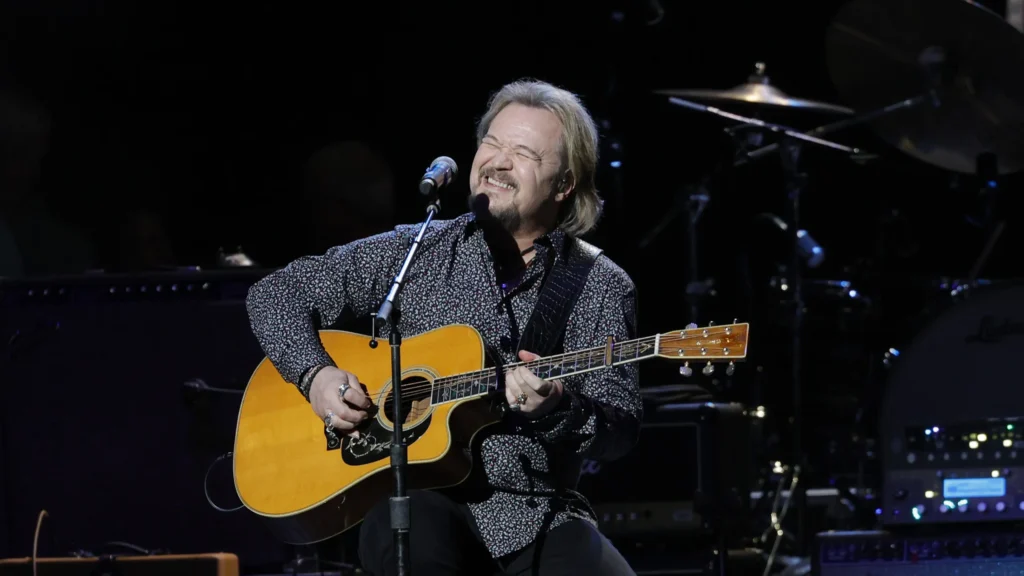
A revved-up manifesto about pride and propulsion—Travis Tritt promising to lace country’s heart with rock’s horsepower, and inviting you to roll the windows down and live a little.
Let’s set the anchors before the memories come rushing in. “Put Some Drive in Your Country” arrived on September 22, 1990 as the fourth single from Travis Tritt’s debut album Country Club. Written by Tritt and produced by Gregg Brown for Warner Bros. Nashville, the record runs 4:20, carried “If I Were a Drinker” on its B-side, and peaked at No. 28 on Billboard’s Hot Country Songs and No. 23 on Canada’s RPM Country Tracks—a respectable showing for a track that wore its Southern rock streak proudly in an era when some programmers were skittish about louder guitars.
If you listen closely, the song all but writes its own backstory. Tritt doesn’t hint at influences; he names them—Roy Acuff, George Jones, Hank Williams Jr., Waylon Jennings—then lays out his mission statement in plain English: “I’d mix Southern rock and country, and that’s just what I did.” It’s not rebellion for rebellion’s sake; it’s a handshake between two traditions that had always shared a back road anyway. Contemporary notes and later critical summaries make the same point: the track’s rock ’n’ roll voltage likely kept it from climbing higher—not a failure so much as a line in the sand.
On the studio floor, you can hear how carefully that line was drawn. The personnel list reads like a who’s-who of ace Nashville players: Larry Byrom sliding glass across the frets, Billy Joe Walker Jr. and Reggie Young trading electric lines that glow without grandstanding, Mike Brignardello’s bass and Steve Turner’s drums gripping the groove, Bobby Ogdin adding just enough piano shimmer, Jim “Jimmy Joe” Ruggiere’s harmonica barking at the edges, with Dana McVicker’s harmonies riding shotgun. That’s the trick of the record: it feels like a barroom burner, but it’s precision-built to cruise.
What the song means—especially to ears seasoned by a few decades—goes beyond volume and tempo. In 1990, Tritt was a young man declaring who he was going to be: a country singer with a rocker’s engine, a southerner who understood that swagger doesn’t work without soul. For many of us, the chorus lands like permission we could’ve used earlier in life. You can keep your roots and still push the pedal. You can love Haggard and still crank the Skynyrd when the road opens up. The lyric’s promise isn’t just musical; it’s human: carry your raising, but don’t be afraid to move—really move—when the moment calls for it.
Placed inside Country Club, the cut also explains why Tritt’s debut felt different. The album gave radio its ballads and mid-tempos, but “Put Some Drive in Your Country” planted a flag, marking the corner where his career would park again and again whenever it needed air and sunlight. That Top 30 peak isn’t a ceiling so much as a mile marker—proof that there was an audience ready to hear steel guitar and Telecaster bite without apology. If you remember dialing through stations on a long two-lane, you can probably still feel how this one lifted the dashboard, the way the snare snapped like a screen door and the guitars threaded the center stripe all the way into the fade.
For older listeners, the song often opens a box of tactile memories: the smell of vinyl seats in summer; a cracked speaker rattling along with the kick drum; gravel popping under the tires as you turn off the blacktop toward the lake, a dance, or nothing in particular. Tritt’s vocal doesn’t brag; it grins—that loose, good-humored baritone that could still turn hard as a boot heel when he leaned on a word. What sticks isn’t adolescent rebellion; it’s permission. Permission to quit apologizing for what you love. Permission to add fuel to the life you’ve already built.
And that’s the quiet paradox of “Put Some Drive in Your Country.” For all its horsepower metaphors and tailpipe heat, the song is really about balance—how the right kind of drive steadies you rather than shakes you loose. Tritt wasn’t tossing out tradition; he was tightening the bolts and pointing it down a wider road. The fact sheet tells one story—**1990 single, fourth from Country Club, No. 28 in the U.S., No. 23 in Canada, Gregg Brown at the helm, Warner Bros. Nashville on the spine—but the memory of it tells another: a chorus you can carry into any season, a reminder that life goes better when you let the rhythm breathe and the engine sing. Wikipedia+1
Key facts, at a glance: Artist: Travis Tritt. Song: “Put Some Drive in Your Country.” Album: Country Club. Writer: Travis Tritt. Producer: Gregg Brown. Label/Cat.: Warner Bros. Nashville 19797. Released: Sept. 22, 1990. Length: 4:20. B-side: “If I Were a Drinker.” Peak: No. 28 (U.S. Hot Country Songs), No. 23 (Canada RPM Country). Notable personnel: Byrom, Walker Jr., Young, Brignardello, Ogdin, Ruggiere, Turner, McVicker. When you play it now, it’s not just nostalgia—it’s a little spark under the hood, a reminder that your story can still accelerate.